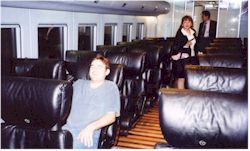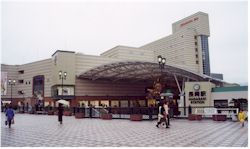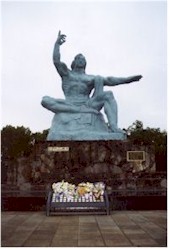| Nagasaki[links] |
October 28, 2000 |
||
Before I get into anything here, I have to openly praise the public transportation systems of Japan. It's all extremely convenient, but the biggest plus is the bullet train, or Shinkansen. The ride is quiet, smooth, and fast, the service is great, and the trains are (gasp!) on time! If you have the opportunity to visit Kyushu, do it, if for nothing other than the trains. I don't know the name of the line that runs from Nagasaki to Fukuoka, but the train was wonderful. The outside was the typical kewl bullet train look, but the inside was much better than your typical Shinkansen. Normally, the Shinkansen interiors are nice enough, with decent amounts of foot room and fold down footrests, but these trains were just luxurious. Leather seats, double the foot room, and hardwood-looking floors. We thought we might have gotten onto the first class section of the train, called the Green Car. Of course, since it was such a nice train, I had to throw a monkey-wrench into things. I lost my ticket. Fortunately, since I had the reserved seat, nobody tried to kick me out, but it was still mightily difficult to explain to the fare inspector. He told me to move, so I nodded, he went away, and I didn't budge. He didn't check back, so it was okay. Certainly, the Atomic Bomb Memorial and Peace Park are the things to see in Nagasaki, but there was another site that caught our attention: the monument to the 26 Christian Martyrs. Within easy walking distance of the station, the site is very simple, but very reverent. In 1587, Christianity was banned in Japan. Of course, the determined missionaries were not deterred. So, in 1597, 6 Jesuit priests and 20 converts (all male) were arrested in Kyoto and Osaka, marched to Nagasaki (not a short haul), and crucified on Nishizaka Hill. The 26 martyrs were sainted by the pope in the 19th century. One of the striking things about the Monument is that several of the martyrs are portrayed as very small. This is due to the fact that the youngest of the martyrs was only 12 years old. Click the image of the memorial to see a closer view. The Monument is an extremely somber place. As we viewed it, there were several Japanese, paying tribute and honor to the 26 Saints. One man seemed to be kneeling in prayer, while others were just standing with their eyes closed. There was a small, interesting
chapel nearby, and we just had to go check it out. At the altar there was a cut stone with 26 crosses around the greek letters Alpha and Omega. It was nice to be in a Christian setting again after so many Buddhist and Shinto places. It just felt homey. Near the hypocenter was a section of a building destroyed in the
blast. The building was a church, and all that remains of it is a
dilapidated wall, standing about 20 feet high. Like the destroyed church, there is a large section of the park devoted
to the remaining foundation of a jail destroyed in the blast, along with
all 144 inmates. It makes you think. Our next stop was Fukuoka. Since it was mainly a rest stop, we didn't take many pictures. One experience we got, though, was the Japanese taxi. Oh, boy. Our short, bald driver was nuts. He had to be! He crowded the other cars, whipping in and out of lanes with little or no regard for other drivers. It was fun though! When he dropped us off, he rattled something in Japanese that I swear no native could have understood. He spoke blindingly fast in a hoarse, high-pitched voice that almost made me laugh out loud. We explored Fukuoka only a little, finding the Canal City mall quite a sight. We never found a mall like American ones. This one was very large, but the main thoroughfare was outdoors, running through the center of the mall along, you guessed it, a canal, complete with a fountain display in the food court. It was nice to just relax a bit before heading to another heavy-hearted place. Not a taxi, but a train...to Hiroshima... Nagasaki Links: [ Main Page ] |
|||
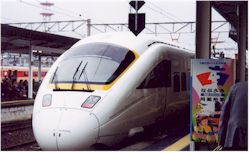
Shinkansen, the famous bullet train. This is the way to travel, let me tell you. Smooth, fast, and comfortable. Actually, this one was especially comfortable. |
|||
|
Ahh...comfort. Leather seats, leg room, and look at the floor in that place. We wondered if we had somehow gotten into the Green car (first class). This was the one we rode to Fukuoka. |
|||
|
Nagasaki Station was another neat looking one. If you look at the larger image, you'll se the dragon hanging from the arched roof there. |
|||
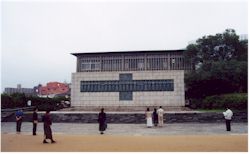
The "26 Christian Martyrs" memorial. Quite a somber place, in a city of somber places. |
|||
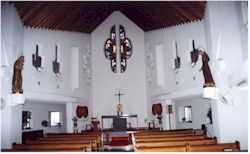
This little chapel was a nice break from all the shrines and temples. |
|||
|
The Peace Statue in Nagasaki's peace park. Maybe one subtle message of the statue is that it takes the strongest people to make peace. |
|||
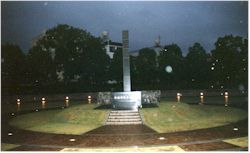
You're looking at the hypocenter of the Atomic Blast. Of course, it exploded above ground, but this is the geographic location. |
|||
|
